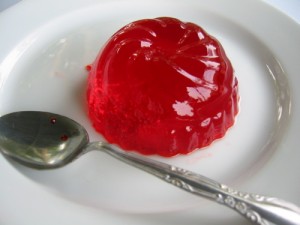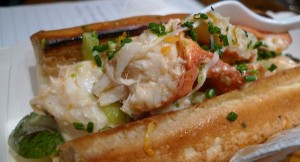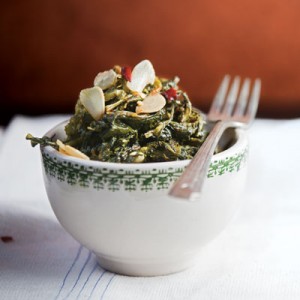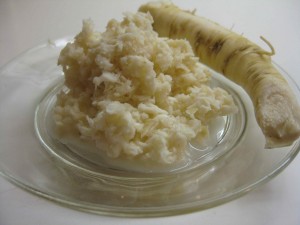Good news. A health magazine recently reported that pork rinds are a (relatively) healthy food. Yes, plenty of fat in these bits of fried pork skins but its a good kind of fat and the skins contain plenty of beneficial oelic acid. Since HG likes to scatter some pork rinds over a bowl of green chili stew the happy report caused HG to muse over other (not so healthy) fried favorites. When HG used to visit the streets of the Washington Heights section of Manhattan (lots of Puerto Ricans, Dominicans and Cubans lived there) HG would often drop into one of the plain spoken restaurants for a favorite meal: Moros y Cristianos ( Moors and Christians–black beans and rice topped with chopped raw onions) and a bowl of Chicharrones (fried pork fat, a by product of lard production). When in a hurry, HG would buy a snack at a Cuchifrito. A Cuchifrito is a colorfully decorated rolling cart that sells freshly made fried foods. (“Cuchifrito” also refers to a whole range of fried pork dishes served in Puerto Rican restaurants). HG remembers with fondness the baccalitos (salt cod pancakes) and rellenos de papas (fried mashed potato balls stuffed with meat or cheese) dispensed by a little cart near St. Nicholas Avenue. However, when HG explores the fried food HG memory bank, the taste standout is old fashioned fried chicken skin (fried in chicken fat, of course) that HG’s Mom cooked while she was rendering schmaltz (chicken fat). A favorite HG childhood sandwich was two slices of Pechter’s Pumpernickel Bread enhanced with an abundance of chicken fat, fried onions and a load of fried chicken skin (gribenes.) Serve a youngster that dish today and it’s off to jail you’ll go for impairing the health of a minor. HG has learned that the Second Avenue Delicatessen in New York (the new one in the East 30’s–the revered old one on Second Avenue closed following a rent dispute) serves a free “amuse bouche” of gribenes. Must indulge on next New York visit.
Pork Rinds – HG’s Favorite Health Food.
April 17th, 2013 § 0 comments § permalink
The West Side Is (was) The Best Side
April 15th, 2013 § 0 comments § permalink
HG has written frequently about the food heaven that was the Upper West Side of Manhattan. Yes, Zabar’s, Murray’s and Barney Greengrass remain — temples of smoked fish and other delicious treats. But, in the days long before the UWS became fully gentrified there were scores of Mom-and-Pop shops, eccentric ethnic restaurants and corner greengrocers that defined the neighborhood’s culinary bent — all have disappeared, crushed by the real estate steam roller. When HG and BSK lived on the West Side during the 1960s and early 1970s the neighborhood was a bastion of rent control. Vast, affordable apartments were legion. Naturally, this attracted writers, artists, musicians, dancers, intellectuals, etc. The neighborhood had an edge. There were plenty of muggers and drug addicts. Petty larceny was the norm. Crazies, huddled in layers of clothing during the warmest weather, wandered the streets mumbling their interior monologues. At night, hookers appeared. There was a melancholy haze over the benches on Broadway where Holocaust survivors, often displaying their concentration camp tattoos, sat ringed in exhaust fumes and polluted sunshine. The great, Nobel Prize-winning author I.B. Singer, a small, pale man in a dark suit and fedora, would chat in Yiddish with these men and women (when he wasn’t feeding pigeons). Impecunious old European refugees favored the Senate Cafeteria on Broadway near 96th Street where they argued endlessly over cups of tea. HG and BSK lived in The Hereford, a moldering 12-story apartment house between West End Avenue and Riverside Drive (glorious views of the Hudson River and the New Jersey Palisades). The building was a repository of the arts. HG and BSK’s dear friend, the composer Michael Small lived with his wife, Lynn, on the fourth floor (HG and BSK lived on the lofty 12th). The Small’s apartment was unusual. Michael’s classmate at Williams College, Charles Gwathmey, the extraordinary architect, had ripped out walls in the apartment creating an exuberant space defined by his beautifully crafted cabinetry. Michael’s grand piano was at stage center. Peter Boyle, the actor (before jumping to fame in Young Frankenstein) lived in the building and joined HG and BSK at a Chinese cooking class. Ted Solotaroff, the visionary critic and editor (founder of The New American Review and lifelong friend of Philip Roth) became a pal of HG and BSK. Here’s a vignette of life at The Hereford: Early one evening Michael summoned HG and BSK to his apartment where he played some of his score to the film Klute (a hit with Jane Fonda as a call girl-in-peril). He went on to write the scores for many memorable films induing All The President’s Men and Marathon Man. After dinner we all went to a literary event at Ted Solotaroff’s apartment. Here, we heard Richard Howard, the poet and translator, read Robert Browning’s My Last Duchess. Memorable. Sadly, Small, Boyle, Gwathmey, Singer and Solotaroff are all gone. Richard Howard is still a figure in New York literary life. And HG continues to remember it all with great fondness.
Listen To Your Mother
April 13th, 2013 § 2 comments § permalink
HG’s late mother, a woman who grew up in pogrom plagued Czarist Russia, believed that all non-Jews harbored an ineradicable hatred of Jews. HG found this ridiculous, but understandable given her background, and cited BSK as an example of a non-Jew devoid of any trace of ethnic, racial or religious animosity. “Just wait,” warned HG’s mother. That’s why, after almost a half-century of marital bliss, HG was startled by an incident last week. HG suggested a breakfast of post-Passover matzo brie. (For the uninitiated, matzo brie is an Ashkenazi Jewish staple — a mix of softened matzos and beaten eggs fried into crisp pancakes. When sprinkled with ground pepper and coarse salt, they are heavenly. Alternatively, sweet toothers like them with a pour of maple syrup.) BSK’s response: “Matzo brie is disgusting. Tastes like eggy old pieces of cardboard.” Wow. Could this be latent anti-semitism rearing its ugly head after all these years? HG then recalled BSK’s distaste for the chicken fat drenched food at Sammy’s Roumanian Restaurant in New York and her luke warm response to kishka (a goose or chicken neck stuffed with garlic and chicken fat enhanced matzo meal). And now this blistering attack against one of the cornerstones of the Jewish table…HG responded angrily: “So, BSK if you are through delighting in Mein Kampf you might want to browse the Protocols of the Elders of Zion and embroider your nightie with swastikas.” HG continued in this vein until BSK exploded: “Go on with this craziness and I’ll cover you in tuna melt and freeze you in a lime Jello mold.” HG has desisted. An uneasy peace prevails.
The Frito Pie
April 13th, 2013 § 2 comments § permalink
HG never encountered the Frito Pie until HG and BSK’s move to New Mexico. Now, it ranks alongside the vaunted Nathan’s Chow Mein Sandwich (available ONLY at Nathan’s Coney Island location) as HG’s favorite messy, silly, funky treat. Let’s clarify one point. The Frito Pie is not a pie. It is composed of a pile of Fritos (yes, those crispy, salty corn things in a bag) covered in beans, red chile, cheddar cheese and topped with shredded iceberg lettuce. Piquant salsa or hot sauce is added to taste. Originally, this was constructed in a very proletarian manner: A bag of Fritos was opened. The chile, beans, etc., were poured into the bag. The bag served as both bowl and a vehicle for transporting this lovely meal. You ate the sauce-drenched corn chips with a spoon. El Parasol (in Pojaque about 15 miles north of Santa Fe) makes the Frito pie a bit more elaborate, serving it in a proper bowl with green chile and chopped raw onions upon request. A crunchy, spicy pleasure. HG believes the original rough and ready Frito Pie is still being served at the Five and Dime Store located on The Plaza in downtown Santa Fe.
Woody Allen’s New York
April 11th, 2013 § 0 comments § permalink
In the early 1950’s, a scrawny kid named Alan Konigsberg was writing gags for New York press agent David Alber. Alber, of course, would submit these little bon mots of humour to the reigning Broadway columnists in exchange for mentions of his clients. At the same time, HG (in his morally conflicted role as journalist and moonlighting press agent) was writing gags and newsy tidbits for the columnists (Walter Winchell, king of the columns, liked HG’s stuff). As HG has often remarked: “I went on to fame and fortune. Wonder what happened to the Konigsberg kid?” Well, Konigsberg changed his name to Woody Allen and has been busy lighting up the world with his comic genius for more than 50 years. These were some HG memories last night as HG and BSK watched Whatever Works, the Allen comedy starring Larry David. Allen originally wrote the movie with Zero Mostel in mind but Mostel died before it could be made. It would have been better with Mostel. Larry David, a gifted comedy writer and a funny man in his improvised riffs on the television program Curb Your Enthusiasm, is not a film actor and can’t really carry a movie. Zero, a mad comic monster, would have been a smash. Still, HG enjoyed the movie because, once more, Woody Allen displayed his intense love for New York. Lots of Greenwich Village street scenes and Chinatown food shopping (lovingly photographed). There’s even a vignette featuring the Yonah Shimmel knish shop on Houston Street. In Allen’s New York everyone seems to live in great apartments or lofts. There’s lots of dining in pleasant restaurants. Best of all, beautiful shiksas (non-Jewish girls) find neurotic, verbal, physically unprepossessing Jewish guys sexually irresistible. As the saying goes: “From Allen’s mouth to God’s ear.” But, maybe Woody has a point. After all. HG met and won the heart of BSK in New York.
Raw Treats
April 10th, 2013 § 0 comments § permalink
HG likes fresh, seasonal raw vegetables. A healthy, festive way to dine with friends is to prepare a very big platter of crudites (as raw vegetables are described on Paris bistro menus.) Broccoli and cauliflower florets. Scallions. Slivers of fennel. Radishes. Slices of young turnip. Red pepper slices. Fava beans in a bowl, sprinkled with olive oil and shavings of pecorino cheese. Set the table with small bowls of good olive oil (fruity Sicilian, robust Greek, flavorful Californian). Maldon Sea Salt. A pepper grinder. Sourdough bread, toasted and rubbed with garlic. Bagna Cauda (olive oil, garlic, anchovy mixture lightly heated)…And, Dukkah. What is “Dukkah,” you may inquire? It is an Egyptian mixture of ground hazelnuts, sesame seeds, spices. A little bit hot. Very addictive. Have lots of red wine and some chilled white ready to pour. Let the feast begin. Dip. Crunch. (HG likes to dunk bread spears into olive oil and dip them in Dukkah. Ah !!). HG follows this with a simple dish of pasta (capellini) with anchovies and garlic (pour the remains of the Bagna cauda over it). Fresh fruit for dessert. Keep the laughter going with after feast grappa, brandy or sambuca.
Faux American In Paris
April 9th, 2013 § 0 comments § permalink
When Paris chefs try to create simple American dishes they fail miserably. Paris is in the midst of a hamburger craze and, according to HG’s informants, the Paris hamburger is laughable. It is devoid of that certain tang that is only achieved at the great American burger emporiums like Bobcat Bite in Santa Fe or Burger Joint in New York (strangely located behind a curtain in the lobby of the super-posh Parker Meridien Hotel). There is some disagreement, but HG believes great steak and fries can only be obtained at the renowned New York steak joints like Spark’s and Peter Luger’s. (Severo, a darling of Parisian critics, serves a pallid version in HG’s opinion). In the latest challenge to American supremacy, The Lobster Roll Bar has opened in a fashionable section of Paris. And, how good is their seaside treat? Fuhgeddabout it !!! Discerning American experts have described the roll as too sweet and the binding mixture as insipid. (And the price for their lobster roll is about $32). If you want to know how to prepare a great lobster roll at home check out HG’s post of Sept. 9, 2012 entitled: Attention Must Be Paid. HG’s advice to the French: Stick to what you do best — escargots and silly philosophising about amour.
Al Dente Vegetables? Not on HG’s Watch!
April 6th, 2013 § 2 comments § permalink
There seems to be a prevalent belief among American professional chefs and home cooks that vegetables should be cooked al dente — just a shade softer than raw. The technique (fostered by the late Julia Child): Blanch vegetables in boiling water. Remove. Stop the cooking by rinsing in ice water. Saute briefly. Serve. HG disagrees. Like our neighbors in the Southern states, HG likes soft vegetables cooked into creamy goodness. (There is an exception. BSK cooks a very al dente broccoli di rabe with lots of garlic and red chili. It’s good. Would be better if she left it in the pan for another ten minutes). HG likes the well done haricot verts in Paris (and the glazed carrots served in bistros with some beef stews). Italians, who can be immoderate in politics, choose a middle way in cuisine. They don’t like things too hot or too cold. And they like–as is proper–vegetables cooked beyond the al dente stage. HG has very few cooked vegetable allies. But, an outstanding advocate of slow and long vegetable cooking is Lesley Porcelli (a woman of Italian lineage, of course). You can find an excellent article by her in the October 2011 issue of Saveur Magazine. Take a peek at her recipes: Slow-coked broccoli di rabe with crushed red chiles and garlic; olive oil braised mixed vegetables; Indian- style carrots with mustard seeds; braised celery and tomatoes; Lebanese-style green beans with chick peas in olive oil. All savory and full of lush flavors.
At Last: A Jewish Delicacy Breakthrough
April 5th, 2013 § 7 comments § permalink
Many, many decades ago when HG was a young New York journalist, HG would join a raffish crowd of late night drinkers at Moe Dubiner’s bar/restaurant on Stanton Street (years before the Lower East Side became cool and trendy). The cuisine was Eastern European Jewish, relished alike by the Irish policemen and the Jewish mob guys and bail bondsmen who made the joint their hangout. HG’s nocturnal snack at Dubiner’s was a big plate of gefilte fish (for the unknowing–this is a type of robust quenelle of minced whitefish and carp poached in fish broth) accompanied by challah, rye bread, pickles and copious amounts of very strong horseradish. Four Roses rye whiskey and beer chasers. These tastes of yesteryear have, thankfully, been rediscovered. Kedem Gourmet Gefilte Fish from Israel (available at Whole Foods) is the real thing. As the label says: “No MSG. No egg yolk. No matzo meal.” The Kedem product has the right density and no sweetness. Its appropriate companion is Lou’s Famous Organic Horseradish. Most bottled horseradish is insipid and tasteless. Not Lou’s. This is powerful stuff with a real bite that must be used with a degree of caution. Clears the sinuses and makes HG feel young again.
Maiko Magic In New Mexico
April 3rd, 2013 § 2 comments § permalink
HG made a premature visit to heaven last night (HG hopes that the HG final–and well deserved–visit to heaven be delayed for a bit). Exquisite Maiko, HG and BSK’s lovely and talented daughter-in-law, gave HG a glimpse of the celestial by preparing a Japanese tempura feast. Here were the elements: Whole wheat soba noodles in broth with a dusting of thinly sliced green onions. Ribbons of crisply fried burdock root. Kinpira Gobo ( braised carrot and burdock root salad in a soy, ginger and garlic dressing). And the tempura — light as air, free of even a trace of grease, flavors enhanced but not concealed: Asparagus, mushrooms, Petrale sole, sliced sea scallops. HG drank a pleasant bottle of Fudo Myoo Junmai Ginjo Sake produced in Oregon. Served very chilled. EM, SJ and family leave New Mexico soon. HG will miss them and the magic of EM’s cuisine.









